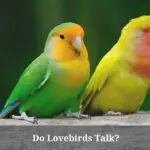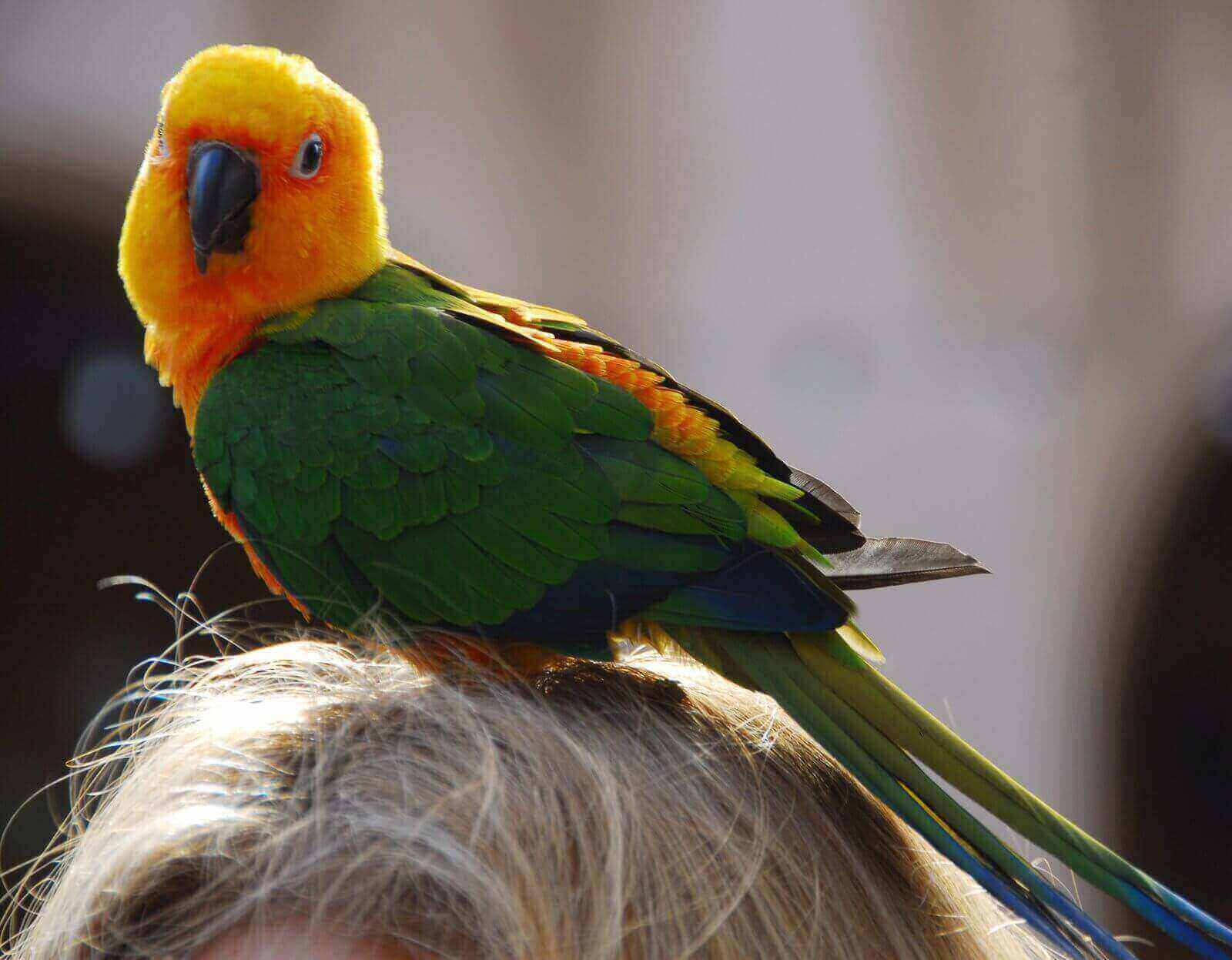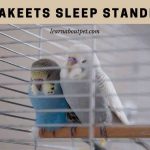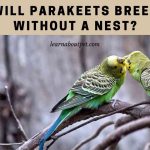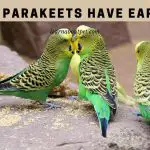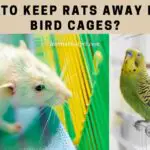If you are considering adopting a bird as a pet, you may find yourself having to choose between a Parakeet and a Lovebird. In that situation, you will want to know how the two differ, and which one is a better pet given your needs. In this article, we compare and contrast the two.
A Parakeet vs Lovebird comparison can be on the basis of body sizes, colors, beak sizes, noise levels and sociability, among other factors. The main thing that sets Parakeets apart from Lovebirds is the fact that Lovebirds are stockier, with tails that are shorter and beaks that are bigger.
Conversely, Parakeets have bodies that are less stocky, but their tails are longer and their beaks are smaller.
The key thing to remember is that both Lovebirds and Parakeets are parrots. Thus when undertaking a Lovebirds vs Parakeets comparison, you need to know that you are comparing parrots.
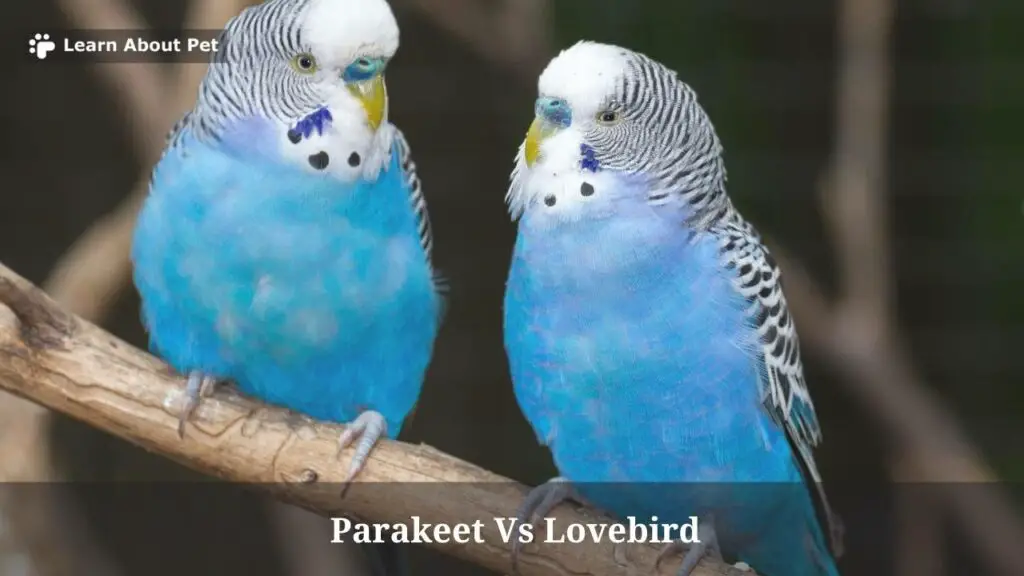
Further, right from the outset, we need to mention that another name for the Parakeet is Budgerigar, or simply Budgie.
Thus what we are undertaking is, in other words, a Budgie vs Lovebird comparison. This is an important point, because there are times when you may find people looking for Budgie vs Parakeet vs Lovebird comparisons.
They do so without knowing that a Parakeet vs Budgie comparison is illogical, as both are the names of the same bird! It is similar to trying to do a Parakeet vs parrot difference comparison: yet the Parakeet is a parrot.
What may make more sense is something like, say, a Cockatiel vs Budgie vs Lovebird comparison.
To avoid such illogicalities then, it is best for us to start by finding out what exactly the Parakeets and Lovebirds are.
What Is A Parakeet?
A Parakeet is best described as a medium size parrot, whose key defining feature is a long tail.
It is important to point out the term ‘Parakeet’ isn’t a reference to a single species. Rather, Parakeet is a reference to many species of parrots, belonging to different genera, but who all share the long tail feature.
Another name for the Parakeet is Budgerigar, or simply Budgie, as mentioned earlier.
What Is A Lovebird?
A Lovebird is best described as a true parrot, belonging to the Agapornis genus.
In the said Agapornis genus, there are actually some 9 distinct species of birds.
These are colorful birds, which originate from the African continent. This is why we sometimes refer to them as African Lovebirds.
Though originating from the African continent, the Lovebirds have over time spread to other parts of the world, including the US where they are widely kept as pets.
How Do You Tell The Difference Between A Lovebird And A Parakeet?
Now that we have defined both the Lovebird and the Parakeet, the next challenge that arises is on how to tell the difference between a Lovebird and a Parakeet.
So, indeed, how do Lovebirds and Parakeets differ? Or, to put it differently, what is the difference between a Budgerigar and a Lovebird?
To understand the differences between Lovebirds and Parakeets, we have to undertake a Parakeet bird vs Lovebird comparison.
That can also be referred to as a Parakeet vs African Lovebird comparison. That is because, as we have already said, the Lovebird has its origins in Africa.
So while there would be no basis for carrying out African Love Birds vs Love Birds comparison, we can certainly do an African Lovebird vs Parakeet comparison.
It is important to mention that there are many types of Parakeets, just as there are many types of Lovebirds.
Thus what we are setting out to undertake is a general Parakeets vs Lovebirds comparison.
We may not be able to venture into a more detailed comparison – like, say, a Lineolated Parakeet vs Lovebird comparison.
Neither may we venture into something as elaborate as, say, a Monk Parakeet vs Lovebird comparison or even a Parrotlet vs Parakeet vs Lovebird comparison.
Our is a more general Lovebird vs Parakeet comparison.
This will be on the basis of things like body size, tail size, color and beak structure.
Let’s get down to it.
Lovebird Vs Parakeet Size
Generally, the Parakeet tends to be slim, whereas the Lovebird tends to be stockier.
Thus one rather simple way to tell the difference between the two is by checking their body sizes.
Given two birds, the slimmer one will tend to be the Parakeet. And the stockier one will tend to be the Lovebird.
This can have implications, when considering Lovebirds vs Budgies as pets to live together. Because the Lovebird tends to be bigger and stronger, it can easily injure the Parakeet, if you keep them together.
All in all, the key thing to note is that the Lovebird tends to be stockier. Conversely, the Parakeet tends to be slimmer.
That is the long and short of any Lovebird vs Budgie size comparison.
Lovebirds Vs Parakeets Tails
The tail of the Parakeet tends to be considerably long, given the bird’s overall size. Indeed, one the defining features of all Parakeets is the long tail.
On the other hand, the tail of the Lovebird tends to be quite short.
So what we end up with here is a paradoxical situation. It is a situation in which the Parakeet is slimmer, but has a longer tail. The Lovebird is stockier, but it has a shorter tail.
All in all, perhaps the most reliable way to differentiate Lovebirds from Parakeets is by looking at the tails.
The one with the longer tail is likely to be the Parakeet. And the one with the shorter tail is likely to be the Lovebird.
This too has implications, when comparing Lovebirds vs Budgies as pets. The longer tail in the Budgie means that handling this bird is easier.
Lovebirds Vs Parakeet Color
For the most part, Parakeets tend to have bodies that are green, but with heads that are yellow. A few have different colors, but most adhere to this color scheme.
Lovebirds on the other hand come in a wider variety of colors. This can be anything from white to peach, including even teal.
Thus in Lovebirds, there is greater color variety. On the other hand, in Parakeets, there is greater uniformity in color.
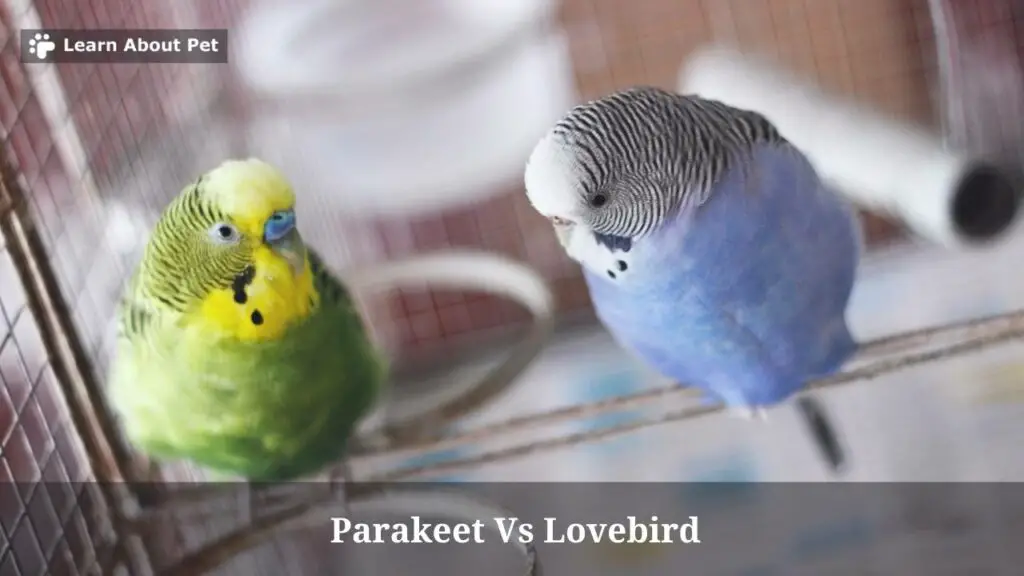
Lovebird Vs Parakeets Beak
Usually, the Parakeet has a beak that is small, or otherwise described as short.
Conversely, the Lovebird tends to have a beak that is bigger, or otherwise described as long.
This too is another factor that may be relevant when undertaking a Lovebirds vs Budgies as pets comparison.
Because the beak of the Parakeet is small, you often have to chop up food before giving it to the bird.
On the other hand, the food for a Lovebird doesn’t require that sort of preparation.
The beak size is even a relevant consideration when thinking of keeping a Budgie and Lovebird together.
Since it has a bigger and stronger beak, the Lovebird is better able to attack the Parakeet.
The combination of a slimmer body and a shorter/weaker beak puts the Parakeet at a disadvantage in any fight with a Lovebird.
Which Is Better Parakeet Or Lovebird?
The question on which is better between Parakeet and Lovebird is an interesting one.
Much really depends on what one is looking for in a pet. For some people’s needs, the Lovebird may be a better pet. And for others, the Parakeet may be a better pet.
Thus you need to do a Parakeets and Lovebirds as pets pros and cons analysis. That is what will tell you which is better Parakeet or Lovebird.
Among the relevant considerations here are the respective birds’ noise levels, independence, training needs, sociability and life expectancy.
Let us look at some of those in turn.
Lovebirds Vs Parakeet Noise Levels
For the most part, the Parakeet tends to be quieter than the Lovebird.
This is an important consideration, if you live in a place with difficult neighbors.
The problem with a Lovebird is its tendency to often making screeching sounds, which some people find very irritating.
Thus if your main desire is for a quiet pet, you are better off going with the Parakeet.
But if you prefer a bigger, more vibrant, more colorful – but also noisier bird – then the Lovebird may be most ideal for you.
Lovebird Vs Parakeet Independence
Generally, Parakeets tend to require more ‘babysitting’ than Lovebirds.
To put it differently, Lovebirds are more independent than Parakeets.
If you want a bird that can stay independent for long without requiring babysitting, then the Lovebird is better.
But if you don’t mind a bird that requires lots of handling, then the Parakeet is quite good.
Most experts say that if you can get two Lovebirds to keep each other’s company, then your handling may not be greatly required. They can be quite independent.
Lovebirds Vs Parakeet Training Needs
Lovebirds seem to have a better ability to retain information than Parakeets.
Thus if you opt for a Parakeet, you need to be ready for almost constant (daily) training. Otherwise the bird will keep on resorting to its wild nature.
For some people, this need for constant training can be an advantage. That is because it translates into an opportunity to bond better with the bird.
But there are those who will find the Lovebird’s ability to retain information for longer better. It means that training a Lovebird is a more rewarding, less frustrating exercise.
Lovebirds Vs Parakeets Sociability
Most people will greatly prefer a pet bird that is highly affectionate.
This leads to a question: which bird is most affectionate: a Budgie or a Lovebird?
And the answer is that the Lovebirds tend to be more sociable. They are also more vibrant.
Thus if your main criteria is that of looking for a sociable bird, you know that the Lovebird is better for you.
Just remember, as we said earlier, that the Lovebird will also tend to be noisier.
Lovebirds Vs Parakeet Life Expectancy
In captivity, Lovebirds typically have a life expectancy in the 10 to 20 years range.
On the other hand, in captivity, Parakeets typically have a lifespan expectancy in the 7 to 15 years range.
Therefore what becomes clear is that, all factors being constant, Lovebirds have longer lifespans than Parakeets.
But it is important to point out that these are just averages. With better care, a Parakeet may be able to live longer than a Lovebird receiving poorer care.
And much also depends on how ‘lucky’ the bird is, with regard to things like accidents and some illnesses.
Generally though, Lovebirds seem to have longer life expectancies than Parakeets.
Can You Put Love Birds With Parakeets?
If it becomes too hard to choose one over the other, you may easily find yourself considering adopting both a Lovebird and a Parakeet.
So, indeed, can Lovebirds be with Parakeets? The answer is that it may be improper to keep a Lovebird with a Parakeet in the same cage.
The Lovebird is stronger, more aggressive and more territorial. So it is likely to keep on attacking the Parakeets, and may injure it badly in the process.
If you have to keep Lovebirds with Parakeets, you better be sure that they are in different cages.
Alternatively, you can get them both while very young, and bring them up together in such a manner that they eventually bond.
Otherwise it is best to just keep them in different cages, to avoid putting the Parakeet in harm’s way.
Final Verdict – Parakeet Vs Lovebird
Both Parakeets and Lovebirds are parrots.
The Parakeets tend to be slimmer, but with tails that are longer. Conversely, the Lovebirds tend to be stockier, but with tails that are shorter.
Parakeets are usually green in color, but with yellow color on their head regions. Other color schemes are possible for them too, though those are rarer.
For Lovebirds, there is greater diversity in colors – including peach, white and teal.

The beaks of Lovebirds tend to be longer and stronger than those of Parakeets. Those of Parakeets are normally shorter and less strong.
Lovebirds can be more independent, requiring less handling than Parakeets.
But the Parakeets are also less noisy than the Lovebirds.
In terms of training, Lovebirds seem to have better ability to retain information. Parakeets require more constant training, to keep them from reverting to their wild behaviors.
With proper care, Lovebirds have somewhat longer life expectancies than Parakeets. But how long an individual bird actually lives depends on factors like the care it gets, its genes and even its luck.
The bottom-line though is that both Parakeets and Lovebirds are amazing birds.
As a pet lover, make sure to learn about pet more and give your pet birds a good and comfortable life!

Welcome to Learn About Pet. My name is Rajkumar Ravichandran and I love all pets, travel, and amazing food. I write about my passion and personal experience caring for multiple pets in this blog! ❤️
Post Disclaimer
DISCLAIMER: THIS BLOG OR WEBSITE, "Learn About Pet", DOES NOT PROVIDE YOU WITH MEDICAL ADVICE AND IS NOT A SUBSTITUTE FOR MEDICAL ADVICE. ALWAYS GET IN TOUCH WITH YOUR PERSONAL VETERINARIAN AND USE INFORMATION HERE AS GENERAL ADVICE.
The information, including but not limited to, text, graphics, images and other material contained on this website are for informational purposes only. No material on this site is intended to be a substitute for professional veterinary advice, food recommendation, diagnosis, or treatment. Always seek the advice of your veterinarian or other qualified health care provider with any questions you may have regarding a medical condition or for pet food related questions.
